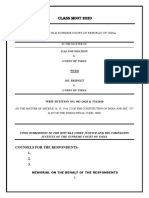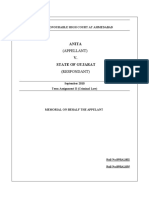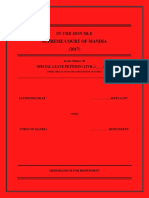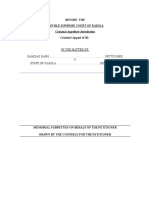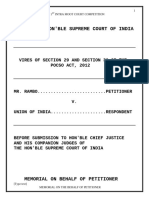(8 Novice Moot Court Competition, 2020-21) : (Memorial For Respondent)
(8 Novice Moot Court Competition, 2020-21) : (Memorial For Respondent)
Uploaded by
bannuCopyright:
Available Formats
(8 Novice Moot Court Competition, 2020-21) : (Memorial For Respondent)
(8 Novice Moot Court Competition, 2020-21) : (Memorial For Respondent)
Uploaded by
bannuOriginal Description:
Original Title
Copyright
Available Formats
Share this document
Did you find this document useful?
Is this content inappropriate?
Copyright:
Available Formats
(8 Novice Moot Court Competition, 2020-21) : (Memorial For Respondent)
(8 Novice Moot Court Competition, 2020-21) : (Memorial For Respondent)
Uploaded by
bannuCopyright:
Available Formats
[8th Novice Moot Court Competition,2020-21]
[Memorial for respondent] Page 1
[8th Novice Moot Court Competition,2020-21]
TABLE OF CONTENTS
LIST OF ABBREVATIONS...........................................................................................................3
INDEX OF AUTHORITIES...........................................................................................................4
STATEMENT OF JURISDICTION...............................................................................................5
STATEMENT OF FACTS..............................................................................................................6
ISSUES RAISED.............................................................................................................................8
SUMMARY OF ARGUMENTS.....................................................................................................9
ARGUMENTS ADVANCED.......................................................................................................11
1. The respondent did not publish any statement which contain defamatory material against
the petitioner..............................................................................................................................11
1.1 The statement made by the respondent were not false & defamatory in nature..............11
1.2 The statement made by the respondent consists of an opinion & a fair comment..........12
1.3 The defendant has qualified privelage.............................................................................13
2. The statement made by Ashok caused no actual damage to Nayak.....................................14
2.1 The petitioner is entitled to no compensation or damages, to be payable by the
respondent , for defaming the plaintiff, & if so to what extent..............................................14
PRAYER........................................................................................................................................16
[Memorial for respondent] Page 2
[8th Novice Moot Court Competition,2020-21]
LIST OF ABBREVATIONS
& - And
§-Section
¶ - Paragraph
AIR – All India Reporter
AIR- All Inida Reporter
All ER – All England Law Report
BOM - Bombay
CPC – Civil Procedure Code
CWN – Calcutta Weekly Notes
Dec - December
Hon’ble - Honourable
ILR- Indian Law Reports
Jan – January
KB – Kings Bench
MHC - Madras High Court
MP – Madhya Pradesh
Nov - November
Pat – Patna
QB – Queen’s Bench
Sd/- - Signed
V. – Versus
[Memorial for respondent] Page 3
[8th Novice Moot Court Competition,2020-21]
INDEX OF AUTHORITES
Cases:
Alexander v. North Eastern Railway Co, [1865] 6 B & S 340.
Dainik Bhaskar v. Madhusudan Bhaskar , AIR 1991 MP 162
Dawkins v. Lord Paulet , (1869) LR 5 QB 94 (102)
Hebditch v. Macllwaine, (1894) 2 QB 54
Horrocks v. Lowe , (1974) 1 All ER 662 (670, 671)
Raghunath damodhar v. Janardhan gopal , (1891) ILR 15 BOM 599
Rangabati v. United Bank Of India Ltd. And Anr, AIR 1961 Pat 158.
Sri Raja Sitarama v. Sri Raja Sanyasi , (1866) 3 MHC 4.
Surendra Nath v. Bageshwari Prasad , AIR 1961 Pat 164 .
Tushar Kanti Ghose v. Bina Bhowmick , (1952) 57 CWN 378.
Watt v. Longsdon, (1930) 1 KB 130.
Acts:
§ 6 of the Defamation Act, 1952
Book:
Ratanlal & Dhirajlal : The Law of Torts (Lexis advance)
[Memorial for respondent] Page 4
[8th Novice Moot Court Competition,2020-21]
STATEMENT OF JURISDICTION
The Respondent humbly submits to the jurisdiction of the Hon’ble high court of Indraprastha
under § 9 and §15 of CPC 1908. Which states, Every suit of civil nature can be approached under
a civil court and Every suit shall be instituted in the Court of the lowest grade competent to try it
respectively.
The present memorandum sets forth the facts, contentions and arguments.
[Memorial for respondent] Page 5
[8th Novice Moot Court Competition,2020-21]
STATEMENT OF FACTS
Background details:
1. Ashok & Nayak are two well-known rival advocates who are specialized in the Arbitration
Law. Nayak & Ashok are ranked first & second, respectively, in a survey conducted by
Advocate Khanij, a renowned advocate ranking website.
2. The COVID-19 pandemic has halted most professions for several months. In the pandemic,
both Ashok’s & Nayak’s profession also was dull.
3. In Jan 2020, Nayak’s office saw a steep decline in the number of clients & there was a decent
rise in the clientele of Ashok since Nov 2020.
4. Nayak is a 60-year-old man living with his wife & a married daughter. His daughter is going
through divorce proceedings & it has been a tough time in his family. He is so attached to his
daughter & was highly depressed about the situation that he could not handle the divorce case by
himself & delegated it to another office.
Ashok is a 45-year-old unmarried man, strives hard to beat Nayak in the profession and intends
to secure No.1 position Arbitration law.
5. Nayak suffers from Asthma since his birth & the trouble remains constant every winter. In the
first week of Dec 2020, the peak of the winter season began. Nayak got hospitalized for
treatment & was put under observation for breathing in Chithram Hospital & got discharged after
four days.
Ashok is conscious of Nayak’s activities & is fully aware of Nayak’s yearly hospital visits &
also has been informed of Nayak’s recent hospitalization.
6. LONARSO is a London-based Arbitration Society was conducting the International
Arbitration Conference, 2020 during the last weekend of Dec 2020.
[Memorial for respondent] Page 6
[8th Novice Moot Court Competition,2020-21]
Corporate Executives generally attend this conference to gain knowledge on Arbitration & to
find out good Arbitrators & counsels, whom they can appoint in future or replace their current
ones, whose work is not satisfactory.
The incident:
7. Ashok & Nayak are regular attendees of these conferences rivalry between Ashok & Nayak is
well known to most of the attendees of the conference & they consider it positively with good
spirit.
8. Nayak could not attend this year’s conference due to personal reasons.
9. Paul Fighter, an international speaker during his speech, explained Nayak’s extraordinary
work in a particular case, intending to inspire & motivate the upcoming advocates who attended
the conference. Not knowing that Nayak didn’t attend the conference, the speaker asked Nayak
to advice on how to gain such skills.
10. Ashok knowing that Nayak did not attend the meeting, unmuted himself & said “A leading
advocate got recently discharged from Chithram Hospital after a four-day treatment. He might
have tested positive or maybe Mentally unstable, who knows! People choose your counsel wisely
& stay safe”.
Then the speaker wished good health & a speedy recovery for Nayak & continued his speech.
11. General Practice of LONARSO is that these live conferences are recorded & uploaded in
KYU TUBE. The recent conference that concluded in the last week of Dec was yet to be
uploaded on KYU TUBE, due to their busy schedule & pending editing related work of the
video.
12. Nayak got to know about Ashok’s statement regarding his hospitalization through a friend
who attended the live conference. Nayak believes that the reason for such a strange & sudden
decline in his clientele from Jan 2020 is Ashok, & decided to sue him & filed a civil suit for
defamation & claim damages.
[Memorial for respondent] Page 7
[8th Novice Moot Court Competition,2020-21]
ISSUES RAISED
1. Whether the respondent have published statement which contain defamatory material against
the petitioner?
2. Whether the statement made by Ashok caused actual damage to Nayak?
[Memorial for respondent] Page 8
[8th Novice Moot Court Competition,2020-21]
SUMMARY OF ARGUMENTS
1. Whether the respondent have published statement which contain defamatory material against
the petitioner?
1.1 Whether the statement made by the defendant was false & defamatory in nature?
If a statement is true, then that could afford a defence against defamation proceedings no action
lies for it even if published maliciously. It is not necessary to prove that the statement is litrealy
true, it is sufficient if it is true in substance.
1.2 Whether the statement consist an opinion?
A statement of opinion must be present, the basis of the opinion is stated and it should be held
that it is reasonable for the publisher to have held the opinion based on facts available at the time
1.3 Whether the defendants had qualified privilege.
Law makers have decided that one cannot sue for defamation in certain instances when a
statement is considered privileged.
The concept of “qualified privilege” often arises in defamation cases, which broadly can offer
protection to a publisher of a statement if they had a legal, moral obligation or interest in making
the publication to another party (conversely the party receiving it had a similar interest to receive
it). If qualified privilege is raised by the Defendant, it is for the Claimant to show that the
publisher did so with “malice”, i.e. some other adverse motive, or else a qualified privilege
defence may assist.
2. Whether the statement made by Ashok caused any actual damage to Nayak?
2.1 Whether the petitioner is entitled to compensation or damages, to be payable by the
respondent , for defaming the plaintiff, & if so to what extent.
[Memorial for respondent] Page 9
[8th Novice Moot Court Competition,2020-21]
Even if the statement published does appear to defame another party, if that party cannot prove
they have suffered actual serious harm or if the damages are too remote to make sense then the
respondent is not liable. For example if a business cannot prove that they have suffered any
financial loss, then the claim may fail. The threshold is high & can frustrate cases which initially
appear to have merit.
The damages provided should be reasonable if defamation is in fact proved.
[Memorial for respondent] Page 10
[8th Novice Moot Court Competition,2020-21]
ARGUMENTS ADVANCED
1. The respondent did not publish any statement which contain defamatory material against the
petitioner.
(¶1) In Rangabati v. United bank1 of India the division bench of Patna High Court at paras 22,
23, 24 and 25 observes as here under:- “Besides the general defences applicable to all actions in
torts, such as, limitation, consent, accord and satisfaction, previous Judgement etc., the three
special defences available in an action for defamation, under the common law, are (1)
justification or truth , or (2) privilege, absolute or qualified, and, (3) fair comment.
1.1 The statement made by the respondent were not false & defamatory in nature
(¶2) This same defences can be upheld for this instant case with the help of , as according to
defences of defamation it is held that in a civil suit the truth is ultimate defence for defamation 2
& its not necessary to justify every detail of the charge or general terms of abuse, provided that
the gist of the libel is proved to be in substance correct, & that the details, etc. , which are not
justified, produce no different effect on the mind of the reader than the actual truth would do.3
(¶3) And in Indian there is no specific difference between libel & slander.
(¶4) Thus, it is enough if the statement though not perfectly accurate is substantially true. 4 This
can be held same for the statement made by the defendant Ashok.
(¶5) Mention must also be made of § 6 of the Defamation Act, 1952 (English) which provides
that in an action for libel or slander in respect of words consisting partly of allegations of fact &
partly of expression of opinion, a defence of fair comment shall not fail by reason only that the
truth of every allegation of fact is not proved if the expression of opinion is fair comment having
regard to such of the facts alleged or referred to in the words complained of as are proved.
1
Rangabati v. United Bank Of India Ltd. And Anr, AIR 1961 Pat 158.
2
Raghunath damodhar v. Janardhan gopal, (1891)ILR15BOM599.
3
Dainik Bhaskar And Anr. v Madhusudan Bhargava And Anr., AIR 1991 MP 162, 168.
4
Alexander v North Eastern Railway Co, [1865] 6 B & S 340.
[Memorial for respondent] Page 11
[8th Novice Moot Court Competition,2020-21]
(¶6) In this instant case the first statement can be proved by going through records of hospitals &
the later statement cannot be proved or verified & this can be upheld.
(¶7) It is humbly submitted before this Court, that in the above case Advocate Ashok did not
utter any defamatory word against Advocate Nayak & he told at the conference what is actually
happened with regard to the health of nayak. The hospitalization of nayak is true & a fact.
Advocate Ashok revealed the same so the statement of Ashok regarding the health of the nayak
does not comes under defamatory statement.
1.2 The statement made by the respondent consists of an opinion & a fair comment
(¶8) If the statement made is an opinion & not a statement or assertion of fact, then the said
statement cannot be termed as defamatory.
(¶9) It is a defence to a defamation claim if the defendent can show that what he said was a
statement of opinion; that the statement complained of indicated the basis of that opinion; & that
an honest person could have held the opinion based on any fact which existed at the time the
statement was made.
In this instant case the second part of the statement is an opinion and a fair comment since the
statement of opinion is made on the fact that Nayak visited the hospital.
(¶10) And again in this instant case the second statement may look rude in the prima facie but it
cannot be taken as grounds for malice as the omission of a mere courtesy could not be taken to
be equivalent to slandering or libelling a man, & is not an actionable wrong.5
1.3 The defendant has qualified privelage.
(¶11) And it is humbly submitted before this Court, that the qualified privilege can be held up for
the defendant.
5
Sri Raja Sitarama v. Sri Raja Sanyasi, (1866) 3 MHC 4.
[Memorial for respondent] Page 12
[8th Novice Moot Court Competition,2020-21]
(¶12) A communication, injurious to the character of another made bona fide from a sense of
duty, legal, moral, or social, & reasonably necessary for the due discharge of such duty, & made
with a belief in its truth, is privileged.6 There must in fact be an interest or duty in the person to
whom the libel is published. It is not sufficient that the maker of the statement honestly &
reasonably believes that the person to whom it is made has such an interest or duty; 7 the person
must have an interest in the matter communicated.8 A privileged occasion in the present context
is “an occasion when the person who makes a communication has an interest or a duty legal,
social or moral, to make it to the person to whom it is made, & the person to whom it is made has
a corresponding interest or duty to receive it. This reciprocity is essential.” 9 The principle is that
“either there must be interest in the recipient & a duty to communicate in the speaker, or an
interest to be protected in the speaker & a duty to protect it in the recipient. 10 But the privilege is
restricted to the communication that is relevant to the duty or interest & does not extend to
irrelevant matters.11 But the test of irrelevant matter is not whether it is logically relevant but
whether in all the circumstances, it can be inferred that the defendant either did not believe it to
be true, or though believing it to be true, realised that it had nothing to do with the particular duty
or interest on which the privilege was based, but nevertheless seized the opportunity to drag in
irrelevant defamatory matter to vent his personal spite or for some other improper motive. 12
(¶13) Therefore, what is published in good faith in matter of these kinds is published on a
privileged occasion & is not actionable even though it may be defamatory & turn out to be
untrue.13 For example- in a case the respondent published a news letter known as the
‘Occupational Health & Safety Bulleton’. It dealt only with matters relating to occupational
health & safety matters & its subscribers were also only those who were responsible for these
matter. Because of this there existed a duty or interest between maker & recipient. In one of its
bulletons the respondent published an article discussing litigation involving a company
controlled by the appellant. The article erroneously reported that the appellant (as opposed to the
6
Prem Narain v. Jogdamba Sahai, (1925) ILR 47 All 859.
7
Hebditch v. Macllwaine, (1894) 2 QB 54.
8
Watt v. Longsdon, (1930) 1 KB 130.
9
Tushar Kanti Ghose v. Bina Bhowmick, (1952) 57 CWN 378.
10
Watt v. Longsdon, (1930) 1 KB 130.
11
Surendra Nath v. Bageshwari Prasad, AIR 1961 Pat 164 .
12
Horrocks v. Lowe, (1974) 1 All ER 662 (670, 671).
13
Id.
[Memorial for respondent] Page 13
[8th Novice Moot Court Competition,2020-21]
company) had been found to have contravened the Trade Practices Act, 1974. Having regard to
all the circumstances of the case the respondent was given the benefit of qualified privilege.
(¶14) In the instant case the defendant believed that the condition of the petitioner should be
known to the Corporate Executives in good faith, who attended the meeting in search for good
Arbitrators & counsels, whom they can appoint in future or replace their current ones, whose
work is not satisfactory.
2. The statement made by Ashok caused no actual damage to Nayak.
2.1 The petitioner is entitled to no compensation or damages, to be payable by the
respondent , for defaming the plaintiff, & if so to what extent.
(¶15) In this instant case it can been seen that,
the COVID-19 pandemic has halted most professions for several months, both Ashok’s &
Nayak’s profession also were dull. & it was in Nov 2020 that there was a rise in clientele
of Ashok that is before the happening of LONARSO so Ashok did not benefit
maliciously from the statement he made and;
the steep decline of Nayak clients in Jan 2021 can be attributed to the continuation of the
pandemic effect & some clients changing their option before LONARSO.
And at last it can be seen that the recording of the conference has not yet been uploaded.
It is humbly submitted before this Court, that the they were no actual damages caused to Nayak
from Ashok’s statement and the petitioner cannot ask damages.
(¶16) Only a successful petitioner in a defamation action is entitled to recover. In addition to
this, even if defamation is proved, the compensation or damages should be reasonable &
proportionate to the alleged injury suffered by the plaintiff.
(¶17) It is permissible to the respondent to seek to mitigate damages by proving the following
circumstances:—
[Memorial for respondent] Page 14
[8th Novice Moot Court Competition,2020-21]
(1) absence of malice, in this case there is no malice as Ashok in good faith and made the
statement in interest of the executives.
(3) apology at the earliest opportunity, And here the petitioner did not ask for any apology or
amends. Some categories of privilege require as a condition that an opportunity be given for a
suitable explanation and contradiction.
PRAYER
[Memorial for respondent] Page 15
[8th Novice Moot Court Competition,2020-21]
Wherefore in the light of questions presented, arguments advanced & authorities cited, it is
humbly prayed by the Respondent before the Hon’ble High Court of Indraprasth, that it may:
1. The respondent cannot be sued or held liable for the statements which are allegedly
defamatory in nature.
2. The respondent statement did not do any actual damages to the petitioner. Hence the petitioner
is not entitled to any compensation or damages from the respondent.
And pass any order which it deems fit in light of justice, equity & good conscience. For this act
of kindness, the Respondent shall duty bound forever pray.
Sd/-
Counsel on behalf of the respondent
[Memorial for respondent] Page 16
You might also like
- Recruitment Services AgreementDocument10 pagesRecruitment Services AgreementArpita MajumdarNo ratings yet
- Essential Soft Skills for Lawyers: What They Are and How to Develop ThemFrom EverandEssential Soft Skills for Lawyers: What They Are and How to Develop ThemNo ratings yet
- Dao-2013-20 Registration of Occupants of Protected AreasDocument23 pagesDao-2013-20 Registration of Occupants of Protected Areascookbooks&lawbooks100% (2)
- Criminal Complaint U Ss 323 & 504 R W Sec. 34 of The Indian Penal Code-Drafting-Criminal Template-1094Document3 pagesCriminal Complaint U Ss 323 & 504 R W Sec. 34 of The Indian Penal Code-Drafting-Criminal Template-1094Lakshmi Narayan Mukherjee100% (6)
- Dona Adela Export International Inc v. TIDCORP and BPI, G.R. No 201931Document2 pagesDona Adela Export International Inc v. TIDCORP and BPI, G.R. No 201931Rhenfacel ManlegroNo ratings yet
- Plaintiff 2 Sem Memorial of SagarDocument23 pagesPlaintiff 2 Sem Memorial of SagarsagarNo ratings yet
- (Affilited To Savitribai Phule University Pune) : SNBP Law CollegeDocument15 pages(Affilited To Savitribai Phule University Pune) : SNBP Law CollegeLata Yadav maindadNo ratings yet
- (TC-17) Memorial On Behalf of Petitioner FinalDocument24 pages(TC-17) Memorial On Behalf of Petitioner FinalDebayan PanditNo ratings yet
- Memorial For Respondent Final PDFDocument32 pagesMemorial For Respondent Final PDFSimran Simmy100% (1)
- Memorial For PlaintiffDocument22 pagesMemorial For PlaintiffAditya SharmaNo ratings yet
- RespondentDocument35 pagesRespondentVrajesh Patel100% (1)
- Akash MemoDocument20 pagesAkash MemoHarshit SinghNo ratings yet
- Appellate MemorialDocument25 pagesAppellate MemorialShreya Bapat100% (1)
- Moot Petitioner 2019 SDocument35 pagesMoot Petitioner 2019 SSonal AgarwalNo ratings yet
- Team 115Document20 pagesTeam 115AMARTYA CHOUBEYNo ratings yet
- MemoDocument18 pagesMemoAsad ZahidiNo ratings yet
- Intra Moot AccusedDocument31 pagesIntra Moot AccusedRitiz AroraNo ratings yet
- MemoDocument20 pagesMemoAnirudh R SNo ratings yet
- Moot ProblemDocument17 pagesMoot ProblemPRANOY GOSWAMINo ratings yet
- TC 08 RespondentDocument17 pagesTC 08 RespondentAditya SinghNo ratings yet
- I T H ' S C I: Tnnlu Moot Court Internals, 2020Document29 pagesI T H ' S C I: Tnnlu Moot Court Internals, 2020aswin donNo ratings yet
- 5th AIMCC (P)Document13 pages5th AIMCC (P)Chirag YadavNo ratings yet
- 377 Respondent SideDocument27 pages377 Respondent SidePRIYANKA NAIRNo ratings yet
- Reva Internal Moot Court 2021-2022 Before The Hon'Ble Supreme Court of PradeshDocument34 pagesReva Internal Moot Court 2021-2022 Before The Hon'Ble Supreme Court of PradeshVismaya SureshNo ratings yet
- NJACDocument14 pagesNJACSaurabh PandeyNo ratings yet
- 8TH Intra Moot Court (Respondent)Document13 pages8TH Intra Moot Court (Respondent)Radhikka AhujaNo ratings yet
- Memorial For ApplicantDocument39 pagesMemorial For ApplicantmidhuNo ratings yet
- Memorial Respondent N11Document22 pagesMemorial Respondent N11loyal music onlyNo ratings yet
- Kalyana PetitionerDocument20 pagesKalyana PetitionerPratyush SaxenaNo ratings yet
- Criminal Law TaDocument16 pagesCriminal Law TaAyush YadavNo ratings yet
- Respondent MemoDocument40 pagesRespondent MemoDevesh Shukla100% (1)
- Petitioner Memorial JU Fol 04Document27 pagesPetitioner Memorial JU Fol 04akshat0tiwari100% (1)
- Respondent - Sample MemorialDocument23 pagesRespondent - Sample MemorialAMITHAB SANKARNo ratings yet
- The Honourable Supreme Court of India C: Pandit Ravi Shankar Shukla, University BeforeDocument19 pagesThe Honourable Supreme Court of India C: Pandit Ravi Shankar Shukla, University BeforeAafreen ParveenNo ratings yet
- In The Hon'Ble Supreme Court of Asnard: Special Leave Petition No. ..... of 2018Document22 pagesIn The Hon'Ble Supreme Court of Asnard: Special Leave Petition No. ..... of 2018Muhammad Dilshad Ahmed AnsariNo ratings yet
- MemoDocument34 pagesMemochandni babunuNo ratings yet
- Petitioner 161Document24 pagesPetitioner 161Swastik GroverNo ratings yet
- 07P (Petitioner) - CMR Moot 2020Document27 pages07P (Petitioner) - CMR Moot 2020MuheebNo ratings yet
- Moot 1 Respondents FINALDocument24 pagesMoot 1 Respondents FINALsangeeth mohanNo ratings yet
- MemorialDocument11 pagesMemorialpraokaNo ratings yet
- Itni Shakti Hume de Na DataDocument25 pagesItni Shakti Hume de Na Datavijay srinivas67% (3)
- Memorial of RespondentDocument16 pagesMemorial of Respondentpriyanka bNo ratings yet
- Pranjal Petitioner DraftDocument30 pagesPranjal Petitioner DraftpranjalNo ratings yet
- Plaintiff MemorialDocument30 pagesPlaintiff MemorialSanjay ChavreNo ratings yet
- Memorial On Behalf of The Respondent by Nameera MerajDocument18 pagesMemorial On Behalf of The Respondent by Nameera Merajnameera merajNo ratings yet
- Moot Proposition AUMP National Moot Court Competition 2019 1Document4 pagesMoot Proposition AUMP National Moot Court Competition 2019 1Jai0% (1)
- Moot Problem 1 (Memorial Respondent's Side) (A VS Union of India)Document19 pagesMoot Problem 1 (Memorial Respondent's Side) (A VS Union of India)Aman SinghNo ratings yet
- Petitioner - Information Technology Act and YPHP ActDocument28 pagesPetitioner - Information Technology Act and YPHP ActAmithab SankarNo ratings yet
- Moot LGBTQDocument3 pagesMoot LGBTQBrendon McNo ratings yet
- Team Code 34 PDocument22 pagesTeam Code 34 PShivam TiwaryNo ratings yet
- Team Code-001: 1 Asian Law College National Moot Court Competition 2020Document33 pagesTeam Code-001: 1 Asian Law College National Moot Court Competition 2020Anusha ReddyNo ratings yet
- Jashmir - SPL RESPONDENTSDocument24 pagesJashmir - SPL RESPONDENTSTarannum khatriNo ratings yet
- Respondent SENT ANSALDocument34 pagesRespondent SENT ANSALhiraNo ratings yet
- Team No.: Before The Hon'Ble Supreme Court of Kakila Criminal Appellate Jurisdiction Criminal Appeal of 20Document18 pagesTeam No.: Before The Hon'Ble Supreme Court of Kakila Criminal Appellate Jurisdiction Criminal Appeal of 20Hrishi KeshNo ratings yet
- Memorial On Behalf of RespondentDocument25 pagesMemorial On Behalf of RespondentAvantika Mahajan100% (1)
- ZXVZBCDocument14 pagesZXVZBCPRINCE KAUSHIKNo ratings yet
- 6 PDocument36 pages6 PRazor RockNo ratings yet
- Memorial On The Behalf of Petitioner.Document29 pagesMemorial On The Behalf of Petitioner.SHOURYANo ratings yet
- Participant Code: R4: DR. RAM Manohar Lohiya National LAW University, LucknowDocument15 pagesParticipant Code: R4: DR. RAM Manohar Lohiya National LAW University, LucknowShreya SinghNo ratings yet
- MemorialDocument13 pagesMemorialRohith BalajiNo ratings yet
- Memorial 20 ADocument28 pagesMemorial 20 AYashi JainNo ratings yet
- Symbiosis Memorial RespondentDocument32 pagesSymbiosis Memorial RespondentMozhiNo ratings yet
- Jaya Bachchan Vs Union of IndiaDocument11 pagesJaya Bachchan Vs Union of IndiaLelouchNo ratings yet
- York County Court Schedule For Nov. 16, 2014Document11 pagesYork County Court Schedule For Nov. 16, 2014York Daily Record/Sunday NewsNo ratings yet
- 4838Document16 pages4838OSDocs2012No ratings yet
- Director of Lands V Ca - 276scra276 - DIGDocument3 pagesDirector of Lands V Ca - 276scra276 - DIGfjl_302711No ratings yet
- JTH Tax, Inc. v. Whitaker - Document No. 34Document2 pagesJTH Tax, Inc. v. Whitaker - Document No. 34Justia.comNo ratings yet
- 42 Soc - Sec.rep - Ser. 638, Unempl - Ins.rep. CCH (P) 17734a Rowell Victor Smart v. Donna Shalala, 9 F.3d 921, 11th Cir. (1993)Document4 pages42 Soc - Sec.rep - Ser. 638, Unempl - Ins.rep. CCH (P) 17734a Rowell Victor Smart v. Donna Shalala, 9 F.3d 921, 11th Cir. (1993)Scribd Government DocsNo ratings yet
- In The Supreme Court of California Appeal of Vexatious Litigant Part 2 Exhibits 9, and 14Document8 pagesIn The Supreme Court of California Appeal of Vexatious Litigant Part 2 Exhibits 9, and 14Jose SalazarNo ratings yet
- Topic 5 NegligenceDocument12 pagesTopic 5 NegligenceKa Ki LauNo ratings yet
- China Banking Vs CA, GR 117604Document2 pagesChina Banking Vs CA, GR 117604kaira marie carlosNo ratings yet
- G.R. No. L-10244Document2 pagesG.R. No. L-10244CharLene MaRieNo ratings yet
- Revised Penal Code NotesDocument4 pagesRevised Penal Code NotesPouǝllǝ ɐlʎssɐNo ratings yet
- Land Titles - Atty. Padilla - Ateneo Law SchoolDocument2 pagesLand Titles - Atty. Padilla - Ateneo Law SchoolFrances Lipnica PabilaneNo ratings yet
- New Hampshire LLC Certificate of FormationDocument5 pagesNew Hampshire LLC Certificate of FormationRocketLawyer100% (1)
- 4 - Foz & Fajardo v. PeopleDocument2 pages4 - Foz & Fajardo v. PeoplealdinNo ratings yet
- Philip Morris, Inc. v. Fortune Tobacco Corporation, G.R. No.158589, June 27, 2006Document16 pagesPhilip Morris, Inc. v. Fortune Tobacco Corporation, G.R. No.158589, June 27, 2006Cza PeñaNo ratings yet
- Constilaw Review NotesDocument52 pagesConstilaw Review NotesnovateresaNo ratings yet
- Chandan Vora v. Commonwealth of Pennsylvania, 3rd Cir. (2013)Document4 pagesChandan Vora v. Commonwealth of Pennsylvania, 3rd Cir. (2013)Scribd Government DocsNo ratings yet
- Idonah Perkins vs. Mamerto Roxas, Et Al., G.R. No. 47517, June 27, 1941Document2 pagesIdonah Perkins vs. Mamerto Roxas, Et Al., G.R. No. 47517, June 27, 1941Sarah Jane-Shae O. SemblanteNo ratings yet
- ADR in Compensation Systems Trying To Make The Adversarial Tort System Itself More User Friendly Arno Akkermans ACHRF 2013Document8 pagesADR in Compensation Systems Trying To Make The Adversarial Tort System Itself More User Friendly Arno Akkermans ACHRF 2013ISCRRNo ratings yet
- Petitioner Vs Vs Respondent: Third DivisionDocument7 pagesPetitioner Vs Vs Respondent: Third DivisionLala PastelleNo ratings yet
- Commercial CasesDocument332 pagesCommercial CasesYam LicNo ratings yet
- JQC Complaint No. No 12385 Judge Claudia Rickert IsomDocument165 pagesJQC Complaint No. No 12385 Judge Claudia Rickert IsomNeil GillespieNo ratings yet
- Filed 05-06-93Document2 pagesFiled 05-06-93legalmattersNo ratings yet
- G.R. No. 143643Document4 pagesG.R. No. 143643Jo-ed Bitang RevillaNo ratings yet
- 2023 Company Law Model QuestionsDocument3 pages2023 Company Law Model Questionsmichellesxavier1894No ratings yet
- Business Law: Basics of Law TAV18NVNL GRDocument26 pagesBusiness Law: Basics of Law TAV18NVNL GREisvina JonušytėNo ratings yet
- Arbitrator Cannot Go Beyond Point of ReferenceDocument4 pagesArbitrator Cannot Go Beyond Point of Referencesneh guptaNo ratings yet






















